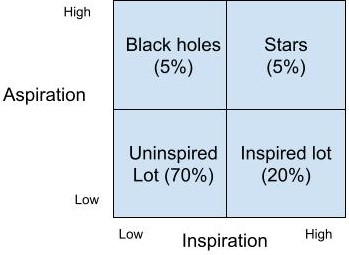All high impact transformation projects in any service operations process would involve changes to the work processes of the frontline staff. A key success factor for any process change is the motivation of frontline staff.
Motivation is a function of two factors – Aspiration and inspiration. The motivation of an aspirational person is self centred, hence can be influenced with the right incentive alignment. The motivation of an inspired person is anchored in the larger goal, hence can be influenced by a larger vision and goal. Each person will have varying levels of aspiration and inspiration at work.
The typical frontline operations team in a service industry will have the following demography based on the two dimensions of aspiration and inspiration.

In any given large scale service process the Uninspired lot would form about 70% of the population, while the other three categories make up the remaining 30% in varying compositions.
Stars are highly motivated folks who would be self starters and early adopters of change. This group should be leveraged for the initial pilot. Since these folks tend to do well in their job the performance of this group will not be representative of the larger team. This group will change fast and will sustain the improvement over long periods with little or no intervention. However most of these folks will very soon move to bigger and better things in life, so just changing this group will not lead to a sustained improvement
Inspired lot generally have very low aspiration, they are the happy folks who are content in their current state. However, they get inspired by larger vision and progress so they will actively take part in new initiatives. This group will be the best bet for championing the change among the larger team. People in the inspired group tend to be stable and hence sustain the change over longer periods
Black holes are team members who are just interested in their own growth and are not easily swayed by the larger goal. This group of people can be motivated with incentives etc.. but generally does not sustain the change as they like the stars move-on too soon.
Hence, for any change to be sustained in the team, we need to get the uninspired lot to accept and adopt the new way of working. Unfortunately, processes are seldom designed for adoption by the uninspired lot. Most focus group discussions or problem solving sessions involve the stars or the inspired lot and hence the outcomes of these exercises rarely brings in the perspective of the uninspired lot who form the bulk of the team.
So how do we change the uninspired lot of the operations team? For most of this group, once the nature of work changes it sticks, the challenge is just to push them over the hill the first time, once they make the change it will stick. So we need to design processes with the characteristics of the uninspired lot in the team.
Here are two ways that I have found usefull while designing the to-be process flow for transactional service operations are
- Most of the resistance from the uninspired lot will be on learning a complex process in a short time. Hence, either design a process that is simpler than the current one or break the change into smaller steps and introduce it one step at a time.
- One of the key drivers of the uninspired lot is to have more time for their interests, hence any change that saves their time will be adopted with lower resistance
There are many sides to a person, these folks are just uninspired at work or the kind of work, one lever is to find a common theme that this group is inspired about and leverage it for the change. If most of the members are football fans, some kind of football themed challenge can drive the change on the floor.
Are there any other factors to consider during process design to make it easier for the inspired lot to adopt?
What are some of the other themes that you have found useful in inspiring the uninspired lot?